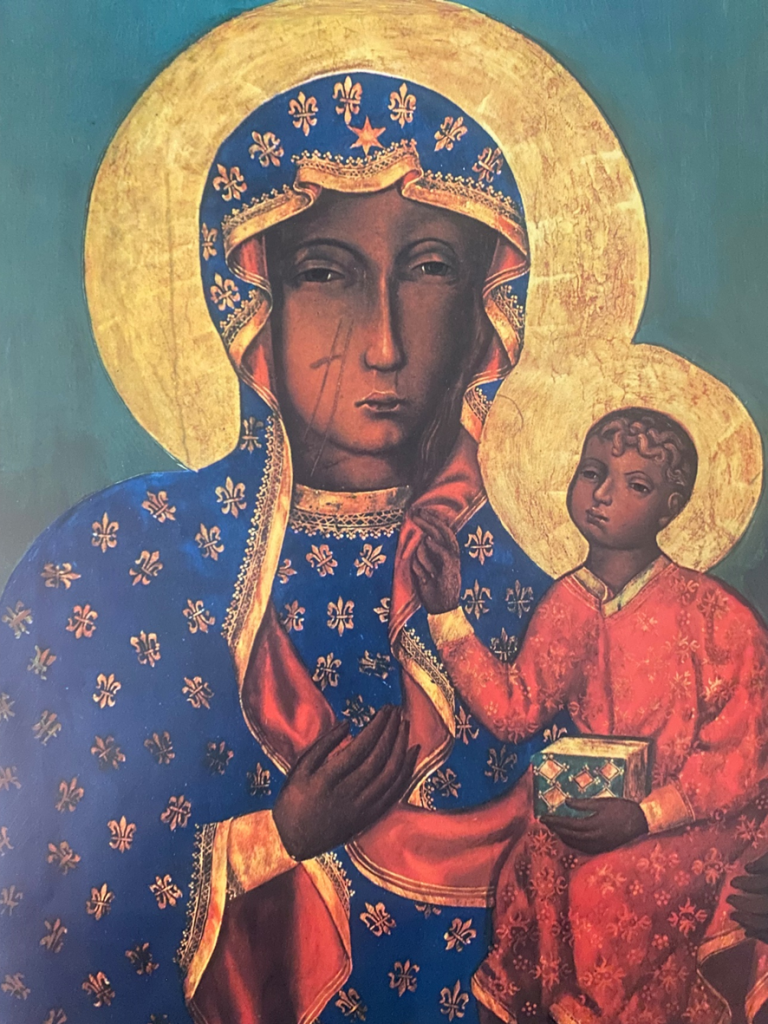

Nossa Senhora da Polônia – Czestochowa
Nossa Senhora da Polônia – Czestochowa
Este título de Nossa Senhora padroeira da Polônia data, mais efetivamente, de 1430, ano em que, no assalto dos russos ao convento e santuário onde estava o milagroso quadro de Nossa Senhora de Czestochowa, todos os documentos escritos sobre a história do quadro se perderam.
De toda forma, a Santa Sé reconhece a data de 7 de setembro de 1382 como o dia em que o milagroso quadro foi instalado na montanha de Jasna Gora, em santuário que, desde os seus primórdios, teve por guardiões os eremitas de São Paulo.
Conta-se, lendariamente, que o quadro foi pintado por Lucas, apóstolo de Cristo, quando Maria ainda era viva, no tampo de uma mesa de madeira feita por José, pai de Jesus.
Tanto que, na Santa Casa de Loretto, onde há uma exposição dos objetos que nela havia quando foi trasladada, consta a seguinte nota: “A mesa de Santa Maria foi encaminhada para a Polônia, e encontra-se na cidade de Czestochowa”.
Segundo historiadores do século XV, parece que o quadro foi levado, primeiramente, para Jerusalém, onde foi encontrado por Santa Helena, que o deu como presente ao imperador Constantino que, por sua vez, o colocou em uma das salas de seu palácio, local em que permaneceu até o ano de 431, quando, então, foi levado para uma igreja desconhecida onde permaneceu escondido até o século IX.
Durante os séculos seguintes, mudou de donos e de lugares diversas vezes, até que, conforme se conta, a própria Maria manifestou o desejo de que ele ficasse em Czestochowa.
Esse desejo foi assim manifestado: o então último possuidor do quadro, o príncipe Wiadslavo, resolveu levá-lo de Belz para Olsztyn, mas, durante a viagem, os animais que puxavam o carro pararam, repentinamente, nas redondezas de Czestochowa, e nenhuma força humana foi capaz de fazê-los continuar viagem.
Depois de longo tempo, assim que tiraram o quadro da carga carregada pelos animais, por terem decidido deixá-lo naquele local, os animais, da mesma forma repentina, puseram-se em movimento.
Mais de um milhão de peregrinos visitam o santuário nacional de Nossa Senhora de Czestochowa todos os anos.
Lady of Poland
This title of Our Lady patron saint of Poland dates, more effectively, from 1430, the year in which, in the attack by the Hussites on the convent and sanctuary where the miraculous painting of Our Lady of Czestochowa was located, all written documents about the history of the painting were lost.
In any case, the Holy See recognizes the date of September 7, 1382 as the day on which the miraculous painting was installed on the mountain of Jasna Gora, in a sanctuary that, since its beginnings, had the hermits of São Paulo as guardians.
It is said, legendarily, that the painting was painted by Luke, an apostle of Christ, when Mary was still alive, on the top of a wooden table made by Joseph, father of Jesus. So much so that, in the Santa Casa de Loretto, where there is an exhibition of the objects that were in it when it was transferred, the following note appears: “The table of Santa Maria was sent to Poland, and is in the city of Czestochowa”.
According to historians from the 15th century, it appears that the painting was first taken to Jerusalem, where it was found by Saint Helena, who gave it as a gift to Emperor Constantine who, in turn, placed it in one of the rooms of his palace, a location where he remained until the year 431, when he was taken to an unknown church where he remained hidden until the 9th century.
During the following centuries, it changed owners and locations several times, until, as it is said, Maria herself expressed her desire for it to stay in Czestoshowa.
This desire was manifested in this way: the then last owner of the painting, Prince Wiadslavo, decided to take it from Belz to Olsztyn, but, during the journey, the animals that were pulling the cart suddenly stopped on the outskirts of Czestochowa, and no human force was able to make them continue their journey.
After a long time, as soon as they removed the frame from the load carried by the animals, having decided to leave it in that place, the animals, just as suddenly, started moving.
More than a million pilgrims visit the national shrine of Our Lady of Czestochowa every year.
Fonte: Ave, Maria – Memnon Edições Científicas – 2014
Produzido por

Consulte a Agenda do Museu a partir de 2025 e o visite quando receber sua confirmação de visita em seu email ou whatsapp.
Por se tratar de um museu particular, é necessário se cadastrar na Comunidade MuMi e customizar sua visita.
Criação e Tecnologia: Clayton Tenório @2025 MuMi – Museu Mítico